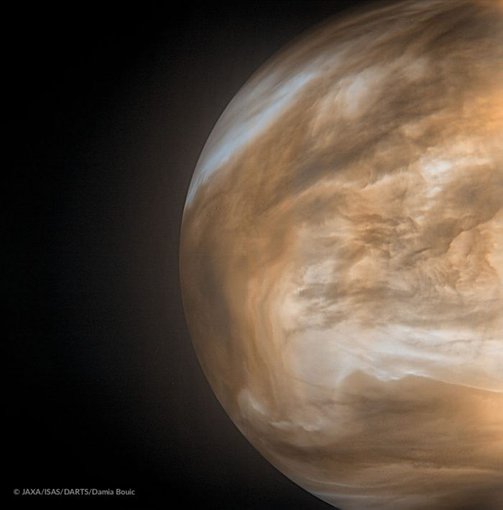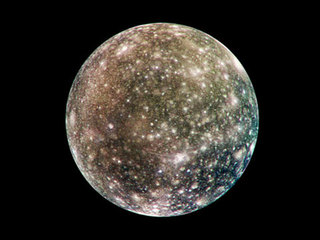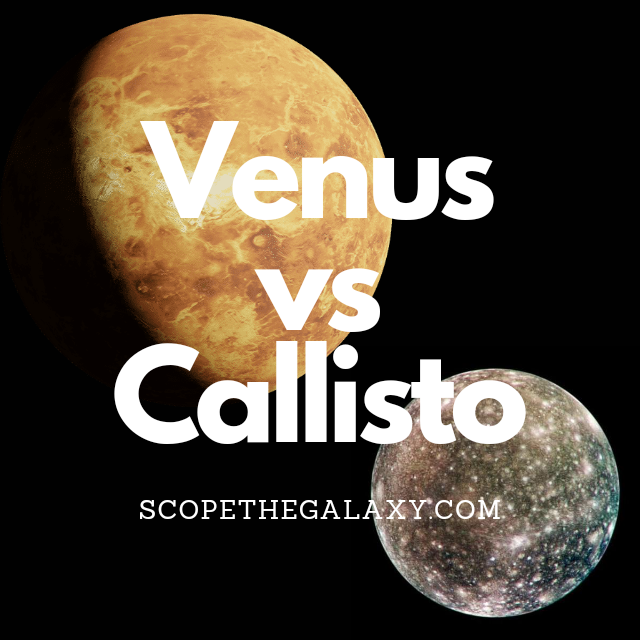*This post may contain affiliate links. This means we may make a commission if you purchase an item using one of our links*
The main differences between Venus and Callisto would be that Venus is both the hottest and brightest entity in the solar system, the 2nd farthest planet from the Sun and has a length of day longer than its orbital cycle around the Sun whilst Callisto is the 3rd largest moon, orbits Jupiter, is the joint 5th farthest and is amongst the most heavily cratered entities in the solar system.
There are various other differences between the two so, continue reading for a more detailed breakdown of both celestial bodies along with an in-depth analysis of their similarities and differences.
What Is The Planet Venus?
Table of Contents

Venus is the 2nd closest planet to the Sun and is often regarded as Earth’s sister planet. It’s very close to our Earth in size where its diameter is 12,104km. This is just over 600km less wide than our home planet.
Unlike all the planets further outside the Sun’s orbit, Venus and even mercury have no moons orbiting it. The most probable reason for this is due to its closer proximity to it, which means that smaller objects orbit the Sun as opposed to Venus.
Venus is also the hottest planet in our solar system where its surface temperature is 475 degrees Celsius. This is due to a number of factors, like the thicker atmosphere, close proximity to Sun, the reasons for which have been explained in more detail here.
It’s core is hot too, similar to that of the ice giants and Earth, where it stands at 5,200 degrees Celsius.
As a result of this thicker atmosphere, Venus is also able to reflect a lot more of the light the Sun projects at it, making it both the hottest and brightness planet in our solar system. This is why for the longest time, and even till this day Venus is often referred to as the morning or evening star.
The thicker atmosphere is mostly compromised of carbon dioxide, and thick clouds of sulfuric acid. This does result sulfuric acid rain on the planets surface, which of course is very corrosive.
Being so close to the Sun also mean its orbital cycle is much shorter. It takes Venus 225 days to complete a full cycle, on the contrary a single day is actually longer than this where it takes around 243 days for a full rotation around its axis.
This is partially down to its distance from the Sun and the thick atmosphere surrounding this terrestrial planet. The axial tilt on Venus is also different from the other planets in our solar system where it is practically straight at 3 degrees.
All in all this is certainly one of the most interesting planets in our solar system and in many peoples eyes, could very well have supported life in the past based on how close its shape and size is to that of Earth.
What Is The Moon Callisto?

Callisto is one of the large moons orbiting Jupiter, the outermost of the Galilean moons, first discovered on 7th January 1610. The surface of this icy world is frozen, but scientists believe an underground ocean could reside beneath the ice.
Even if there’s water on Callisto, it won’t necessarily hold life because the surface is so old. Scientists will need to conduct more research into the moon before determining whether this is a likely possibility.
The ESA’s JUICE (Jupiter Icy Moon Explorer) mission is focused on the three ice moons of Jupiter. It is expected to arrive in 2030 and will focus on learning more about the environment of each, as well as their potential for hosting life.
Scientists estimate that Callisto is around 4.5 billion years old (the same age as Jupiter), and its average distance from the Sun is approximately 778 million km. It has a diameter of 4820.6km, which makes it similar in size to the planet Mercury, and the average temperature is a frigid minus 139.2 degrees Celsius.
Callisto takes seven days to orbit its planet at an average distance of 1,880,000km, and it is tidally locked, meaning the same side of it always faces Jupiter. But this moon experiences less tidal influence than the other Galilean moons because it lies in the orbit of Jupiter’s primary radiation belt.
The name of this moon is derived from the stories of Greek myth. Callisto was the nymph who had an affair with Zeus, the King of the Gods. Upon hearing this news, Zeus’ wife Hera turned Callisto into a star and placed her in the Ursa Major constellation. Interestingly, every moon of Jupiter is named after a Greek figure who Zeus seduced.
Callisto may be the third biggest moon and similar in size to the planet Mercury, but it only has a mass of 107,593,737,963.819 billion kg. That may sound like a lot, but it’s only ⅓ the mass of the similarly sized Mercury.
You may wonder why scientists classify Callisto as a “moon” rather than a planet if it’s almost the same size as Mercury. The reason is simple; planets must orbit the sun, but Callisto orbits one of the planets.
The composition of this frigid world is around 60% rock and iron and 40% ice. The moon has roughly equal amounts of rock and ice, plus the potential for water below the surface. There are also traces of carbon dioxide, organic compounds, and silicates.
This moon is one of the oldest landscapes in the Solar System and the most heavily cratered body in our system. However, scientists believe this could now be a “dead” moon as there are no longer any signs of volcanism or plate tectonics on its surface.
How Are Venus And Callisto Similar?
Callisto and Venus do have their odd few similarities, which in this case includes the below:
- Both have a hotter central core.
- Both have an atmosphere and a rocky surface.
- Both are a spherical shape.
- Both are part of the same solar system.
- Both have no rings surrounding them.
- Neither have other moons orbiting them.
Differences Between Venus And Callisto
In regards to the differences between the two, they include the following:
- Venus is the bigger of the two with a diameter of 12,104km compared to Callisto’s diameter that is 4,820.6km.
- Callisto orbits Jupiter in an elliptical pattern whilst Venus orbits the Sun in a nearly circular pattern.
- Callisto is tidally locked to Jupiter whilst Venus isn’t tidally locked to any other object.
- Venus has an atmosphere 90 times the thickenss of Earth’s consisting of 95.32% carbon dioxide, 2.7% nitrogen, 1.6% argon and 0.13% oxygen whilst Callisto has a very thin carbon dioxide based exosphere.
- Callisto is one of the most heavily catered entities in our solar system as it has 142 named craters with a lot more smaller ones scattered throughout the moon whilst Venus has fewer craters due to its atmosphere breaking debris down resulting in 900 currently named one’s.
- A day on Callisto takes 17 days whilst Venus completes a day in 243 days.
- Venus orbits the Sun in 225 days whilst Callisto orbits the Sun in 12 years and around Jupiter in 17 days.
- Callisto’s density is 1.83 g/cm³ whilst Venus’ density is 5.24 g/cm³.
- In regards to axial tilt, Venus’ is 3 degrees whilst Callisto’s is practically 0 degrees.
- Venus is the hottest celestial object in our solar system with an average temperature of 475 degrees Celsius whilst Callisto’s temperature is -139.2 degrees Celsius.
- Venus has tectonic plates whilst Callisto does not.
- As for mass, Callisto’s is 1.07 x 10^23 kg whilst Venus has a mass of 4.867 × 10^24 kg.
- Venus has a gravitational strength of 8.87 m/s² whilst Callisto’s is 1.236 m/s².
- Venus is the brightest celestial body (besides the Sun) in our solar system whilst Callisto isn’t even the brightest moon.
Summary
Venus and Callisto do have a few similar features such as the lack of a moon orbiting them, their terrestrial nature and their spherical shape but, other than these elements, the two differ greatly.
Whether it be in regards to mass, size, the thickness of their atmosphere, their temperatures, brightness and beyond, the two are very much their own distinct entities.

